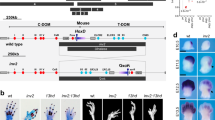Abstract
MICE with targeted disruptions1 in Hoxgenes have been generated to evaluate the role of the Hox complex in determining the mammalian body plan. This complex of 38 genes encodes transcription factors that specify regional information along the embryonic axes. Early in vertebrate evolution an ancestral complex shared with invertebrates was duplicated twice to give rise to the four linkage groups (Hox A, B, C and D)2,3. As a consequence, corresponding genes on the separate linkage groups, called paralogues, are most closely related to each other. Based on sequence similarities, the Hox genes have been subdivided into 13 paralogous groups. The five most 5′ groups (Hox9–13) pattern the posterior region of the vertebrate embryo and the appendicular skeleton4–18. Mice with individual mutations in the paralogous genes hoxa-11 and hoxd-11 have been described15–18. By breeding these two strains together we have generated double mutants which have dramatic phenotypes not apparent in mice homozygous for the individual mutations. The radius and the ulna of the forelimb are almost entirely eliminated, the axial skeleton shows homeotic transformations, and there are severe kidney defects not present in either single mutant. The limb and axial phenotypes are quantitative: as more mutant alleles are added to the genotype, the phenotype becomes progressively more severe. The appendicular skeleton defects suggest that paralogous Hoxgenes function together to specify limb outgrowth and patterning along the proximodistal axis.
Similar content being viewed by others
References
Capecchi, M. R. Scient Am. 270, 54–61 (1994).
Holland, P. W. H., Garcia-Fernandez, J., Williams, N. A. & Sidow, A. Development (Suppl.), 125–133 (1994).
Ruddle, F. H. et al. A. Rev. Genet. 28, 423–442 (1994).
Dollé, P., Izpisúa-Belmonte, J.-C., Falkenstein, H., Renucci, A. & Duboule, D. Nature 342, 767–772 (1989).
Dollé, P., Izpisúa-Belmonte, J.-C., Brown, J. M., Tickle, C. & Duboule, D. Genes Dev. 5, 1767–1776 (1991).
Duboule, D. Curr. Opin. Genet. Dev. 1, 211–216 (1991).
Izpisúa-Belmonte, J.-C., Tickle, C., Dollé, P., Wolpert, L. & Duboule, D. Nature 350, 585–589 (1991).
Izpisúa-Belmonte, J.-C., Falkenstein, H., Dollé, P., Renucci, A. & Duboule, D. EMBO J. 10, 2279–2289 (1991).
Yokouchi, Y., Sasaki, H. & Kuroiwa, A. Nature 353, 443–445 (1991).
Duboule, D. BioEssays 14, 375–384 (1992).
Izpisúa-Belmonte, J.-C. & Duboule, D. Devl Biol. 152, 26–36 (1992).
Morgan, B. A., Izpisúa-Belmonte, J.-C., Duboule, D. & Tabin, C. Nature 358, 236–239 (1992).
Dollé, P. et al. Cell 75, 431–441 (1993).
Haack, H. & Gruss, P. Devl Biol. 157, 410–422 (1993).
Small, K. M. & Potter, S. S. Genes Dev. 7, 2318–2328 (1993).
Davis, A. P. & Capecchi, M. R. Development 120, 2187–2198 (1994).
Favier, B., Le Meur, M., Chambon, P. & Dollé, P. Proc. natn. Acad. Sci. U.S.A. 92, 310–314 (1994).
Li, H. M. H. et al. Development 121, 1373–1385 (1995).
Condie, B. G. & Capecchi, M. R. Nature 370, 304–307 (1994).
Rancourt, D. E., Tsuzuki, T. & Capecchi, M. R. Genes Dev. 9, 108–122 (1995).
Shubin, N. H. & Alberch, P. Evol. Biol. 20, 319–387 (1986).
Oster, G. F., Shubin, N., Murray, J. D. & Alberch, P. Evolution 42, 862–884 (1988).
Duboule, D. Science 266, 575–576 (1994).
Tabin, C. Cell 80, 671–674 (1995).
Niswander, L., Tickle, C., Vogel, A., Booth, I. & Martin, G. R. Cell 75, 579–587 (1993).
Fallon, J. F. et al. Science 264, 104–107 (1994).
Niswander, L., Jeffrey, S., Martin, G. R. & Tickle, C. Nature 371, 609–612 (1994).
Cohn, M. J., Izpisúa-Belmonte, J.-C., Abud, H., Heath, J. K. & Tickle, C. Cell 80, 739–746 (1995).
Peterson, R. L., Papenbrock, T., Davda, M. M. & Awgulewitsch, A. Mech. Dev. 47, 253–260 (1994).
Author information
Authors and Affiliations
Rights and permissions
About this article
Cite this article
Davis, A., Witte, D., Hsieh-Li, H. et al. Absence of radius and ulna in mice lacking hoxa-11 andhoxd-11. Nature 375, 791–795 (1995). https://doi.org/10.1038/375791a0
Received:
Accepted:
Issue Date:
DOI: https://doi.org/10.1038/375791a0
- Springer Nature Limited
This article is cited by
-
Calcium sensing and signaling are impaired in the lumbar spine of a rat model of congenital kyphosis
European Spine Journal (2023)
-
Context-dependent enhancer function revealed by targeted inter-TAD relocation
Nature Communications (2022)
-
Gene expression changes during the evolution of the tetrapod limb
Biologia Futura (2022)
-
The molecular genetics of human appendicular skeleton
Molecular Genetics and Genomics (2022)
-
Origins, potency, and heterogeneity of skeletal muscle fibro-adipogenic progenitors—time for new definitions
Skeletal Muscle (2021)





